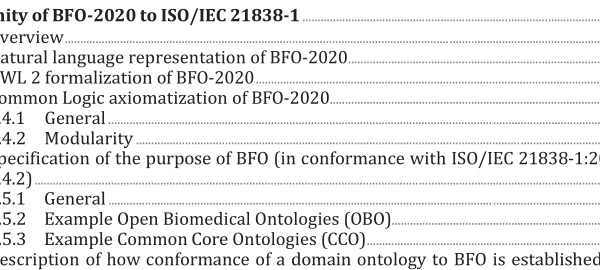ISO IEC 21838-2:2021 pdf download – Information technology — Top-level ontologies (TLO) — Part 2: Basic Formal Ontology (BFO).
1 Scope This document describes Basic Formal Ontology (BFO), which is an ontology that is conformant to the requirements specified for top-level ontologies in ISO/IEC 21838-1. It describes BFO as a resource designed to support the interchange of information among heterogeneous information systems. The following are within the scope of this document: — definitions of BFO-2020 terms and relations; — axiomatizations of BFO-2020 in OWL 2 and CL; — documentation of the conformity of BFO-2020 to the requirements specified for top-level ontologies in ISO/IEC 21838-1; — specification of the requirements for a domain ontology if it is to serve as a module in a suite of ontologies in which BFO serves as top-level ontology hub by providing a starting point for the introduction of the most general terms in those domain ontologies which are its nearest neighbours within the suite; — specification of the role played by the terms in BFO in the formulation of definitions and axioms in ontologies at lower levels that conform to BFO. The following are outside the scope of this document: — specification of ontology languages, including the languages RDF, OWL, and CL standardly used in ontology development; — specification of methods for reasoning with ontologies; — specification of translators between the notations of ontologies developed in different ontology languages. 2 Normative references The following documents are referred to in the text in such a way that some or all of their content constitutes requirements of this document. For dated references, only the edition cited applies. For undated references, the latest edition of the referenced document (including any amendments) applies. ISO/IEC 21838-1:2021, Information technology — Top-level ontologies (TLO) — Part 1: Requirements 3 Terms and definitions For the purposes of this document, the terms and definitions given in ISO/IEC 21838-1 and the following apply. ISO and IEC maintain terminological databases for use in standardization at the following addresses: — ISO Online browsing platform: available at https://www.iso .org/obp
3.1 primitive expression for which no non-circular definition can be provided 3.2 universal type entity (3.1) that has indefinitely many instances ( 3.6 ) EXAMPLE Electron, molecule, cell, planet, explosion, vehicle, hour, traffic law, organization, mortgage contract, email message. Note 1 to entry: References to universals are employed in the formulation of the assertions of natural science and of analogous general assertions in technical manuals, experimental protocols or legal or administrative documents. 3.3 extension collection (3.4) of instances of a universal (3.2) Note 1 to entry: In OWL, every Class is associated with a Class Extension, which is the set of Instances of the Class. In Reference [4] (from 2004), it is asserted that: “A class has an intensional meaning (the underlying concept) which is related but not equal to its class extension. Thus, two classes may have the same class extension, but still be different classes.” 3.4 collection group of particulars Note 1 to entry: The particulars in a collection are called its members. Note 2 to entry: The term “collection” is to be understood as allowing change of members over time (see ISO/IEC 21838-1:2021, B.3.2). 3.5 defined class collection (3.4), whose members are defined by specifying a restriction on one or more universals (3.2), that is not the extension (3.3) of any universal (3.2) EXAMPLE Non-smoker (meaning: person who does not smoke); pet (meaning: animal that is kept for companionship or pleasure); mortgagee (meaning: person with a mortgage); lathe operator (meaning: person with an employment role realized through operating a lathe); target (meaning: thing or process that is targeted). Note 1 to entry: In the OWL 2 community the expression “Defined Class” is sometimes used informally to refer to those Classes in an ontology in which both necessary and sufficient conditions are provided, as contrasted with what are called “Primitive Classes” for which only necessary conditions are provided.
ISO IEC 21838-2:2021 pdf download – Information technology — Top-level ontologies (TLO) — Part 2: Basic Formal Ontology (BFO)






